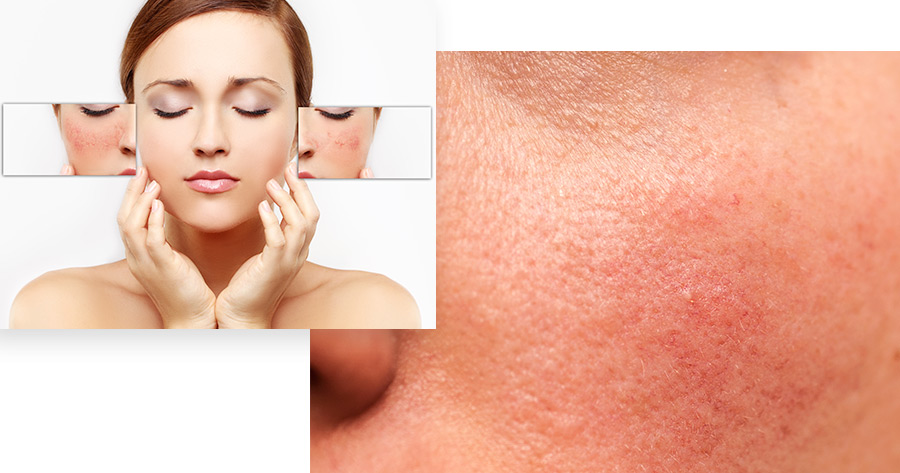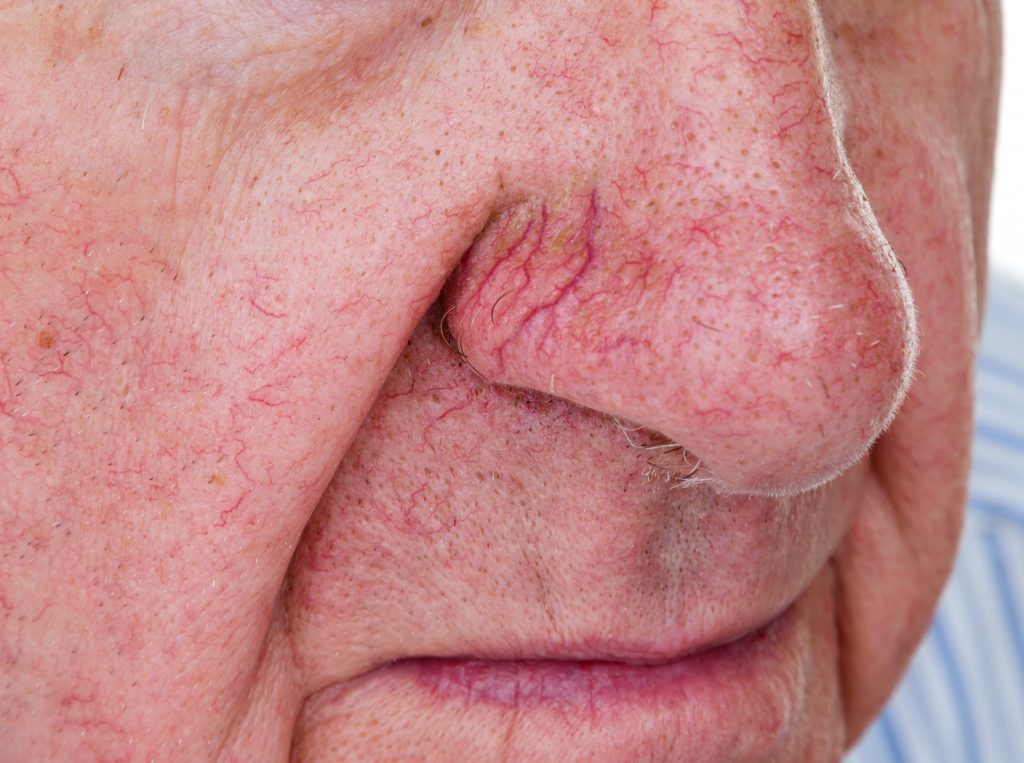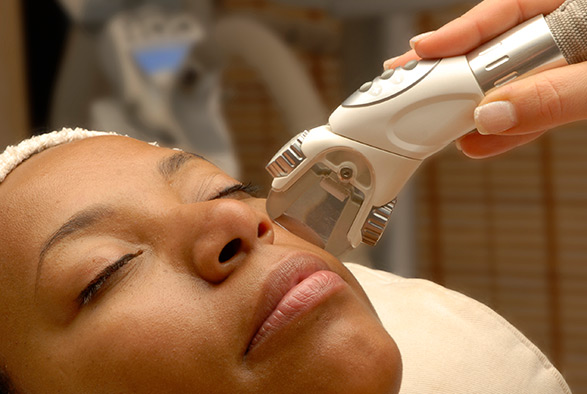Treatment for Broken Blood Vessels on the Face
Broken blood vessels are a common cosmetic concern for many individuals.
At Advanced Dermatology P.C., we understand the importance of feeling good in the skin you’re in, whether your skin condition poses a medical concern or not.
If you’re interested in learning more about this condition or exploring effective treatment for broken blood vessels on the face, we are here to help.
Continue reading to learn about the causes and available treatments for broken blood vessels on the face, equipping you with the knowledge to make informed decisions about your skin health.
What Are Broken Blood Vessels?
Broken blood vessels on the face, medically known as telangiectasia, is a dermatological condition caused by weakened and dilated blood vessels that appear visible near the skin’s surface. These often show up as thin red, purple, or blue lines or spiderweb-like patterns, typically on the cheeks, nose, and around the chin.


What Causes Broken Blood Vessels on The Face?
Broken blood vessels on the face can arise from a variety of factors. The most common causes include:
- Genetics: In many cases, there’s a hereditary link. If family members have them, you’re more likely to develop them too.
- Sun Damage: Excessive sun exposure weakens blood vessel walls, making them more prone to breakage.
- Age: Our skin naturally loses elasticity as we age, and blood vessels become more fragile.
- Rosacea: This chronic skin condition can cause facial redness, flushing, and broken blood vessels.
- Skin Conditions: Certain conditions like rosacea, lupus, and scleroderma can contribute to broken blood vessels.
- Changes in Pressure: Sudden changes in pressure, like during strenuous activity, vomiting, or flying, can cause them to burst.
- Skin Thinning: Thinning skin, often due to aging or steroid creams, makes blood vessels more visible.
- Lifestyle Factors: Alcohol consumption, smoking, and hot temperatures can increase the risk.
- Injury: Direct trauma to the face can damage blood vessels.
It’s important to note that this skin condition is usually harmless, but consulting a dermatologist is recommended if you’re concerned or have a sudden increase and want to learn more about how to repair broken blood vessels on your face.
Broken Blood Vessels on the Face vs. Vascular Lesions
Broken blood vessels on the face and vascular lesions are distinct skin conditions characterized by specific attributes and underlying causes.
Broken blood vessels are visible tiny blood vessels near the skin’s surface, often resembling red or purple lines or clusters. These damaged blood vessels occur due to the expansion of small blood vessels caused by alterations in blood flow. Typically found on the cheeks, nose, and chin, broken blood vessels can appear anywhere on the face and may occasionally lead to symptoms such as mild discomfort or tingling.
In contrast, vascular lesions encompass broader skin irregularities, including birthmarks, hemangiomas, and port-wine stains. These lesions vary in appearance, ranging from flat patches to raised lumps, and can present as shades of red, pink, purple, or blue, depending on the type and depth of the affected blood vessels.
The causes of vascular lesions depend on their specific type. For instance, birthmarks emerge at birth due to abnormal blood vessel development. Hemangiomas are benign blood vessel growths that develop during infancy, and port-wine stains result from blood vessel malformations.
Similar to the location of broken blood vessels, vascular lesions can be anywhere on the body, including the face. Many are benign and asymptomatic, but some can induce pain, swelling, or other symptoms.

How To Get Rid of Broken Blood Vessels on the Face
If you’ve ever wondered how to fix broken blood vessels on your face, we are here to provide guidance.
Laser therapy is the most effective broken blood vessels on face treatment on the nose and other areas of the face.
With this, the visible blood vessels are removed by light absorbed by the blood, which destroys the vessel. After some time, the vessel disappears, restoring the skin’s natural appearance.
Lasers allow quick treatment of broken blood vessels without damaging the surrounding skin. For maximum comfort, you may apply topical anesthesia or ice to the vessel before laser treatment. Lasers are safe, producing gradual results.
Large veins may require multiple treatments for improvement. Small veins require a single treatment for complete repair.
Laser treatment has very few side effects. Treatments may result in temporary discoloration of the affected skin, which can last 5-14 days, depending on the location and size of the vessel being treated. Blistering, crusting, or skin redness may also occur but clear within a few days.
After laser treatment, the use of sunscreen on the treated area is recommended for optimum results, promoting healing and enhancing the effects, similar to what you can see in our before and after broken blood vessels treatment results.
Frequently Asked Questions About Broken Blood Vessels on the Face
I have broken blood vessels on my face. Should I be concerned for my health?
No, often, broken blood vessels on the face are no more than a visual imperfection that patients want removed for cosmetic reasons. They pose no medical harm and can be covered up by makeup. In some cases, although rare, broken blood vessels may be a sign of an underlying condition.
The board-certified dermatologists and physician assistants at Advanced Dermatology, P.C. will work with you directly to determine the best treatment option.
Is it normal to see broken blood vessels on my face after vomiting?
Yes, it’s fairly common. Straining during vomiting can cause tiny blood vessels near the face to burst, showing as red dots. These usually clear up on their own within a few days.
Can I develop broken blood vessels on my face from crying?
Crying itself is unlikely to cause broken blood vessels. However, forceful exertion can sometimes increase pressure and contribute to them.
How are broken blood vessels formed?
Broken blood vessels can form along the face and body for several reasons. Some patients may be genetically prone to experiencing them, while others develop them because of UV damage, weather changes, pregnancy, excessive smoking or drinking, or trauma to the skin.
How does laser treatment help for broken blood vessels on the eyelid, nose, or face?
Laser treatment targets imperfections on your face. Light safely penetrates skin layers without harming the surface, making it a non-invasive treatment.
